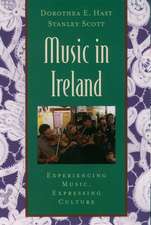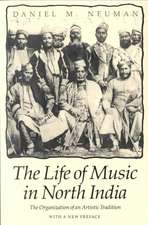SamulNori: Contemporary Korean Drumming and the Rebirth of Itinerant Performance Culture: Chicago Studies in Ethnomusicology
Autor Nathan Hesselinken Limba Engleză Mixed media product – 29 mar 2012
In 1978, four musicians crowded into a cramped basement theater in downtown Seoul, where they, for the first time, brought the rural percussive art of p’ungmul to a burgeoning urban audience. In doing so, they began a decades-long reinvention of tradition, one that would eventually create an entirely new genre of music and a national symbol for Korean culture.
Nathan Hesselink’s SamulNori traces this reinvention through the rise of the Korean supergroup of the same name, analyzing the strategies the group employed to transform a museum-worthy musical form into something that was both contemporary and historically authentic, unveiling an intersection of traditional and modern cultures and the inevitable challenges such a mix entails. Providing everything from musical notation to a history of urban culture in South Korea to an analysis of SamulNori’s teaching materials and collaborations with Euro-American jazz quartet Red Sun, Hesselink offers a deeply researched study that highlights the need for traditions—if they are to survive—to embrace both preservation and innovation.
Din seria Chicago Studies in Ethnomusicology
-
 Preț: 215.23 lei
Preț: 215.23 lei -
 Preț: 266.53 lei
Preț: 266.53 lei -
 Preț: 240.23 lei
Preț: 240.23 lei - 8%
 Preț: 564.74 lei
Preț: 564.74 lei -
 Preț: 184.64 lei
Preț: 184.64 lei -
 Preț: 103.15 lei
Preț: 103.15 lei -
 Preț: 200.20 lei
Preț: 200.20 lei -
 Preț: 214.61 lei
Preț: 214.61 lei -
 Preț: 185.07 lei
Preț: 185.07 lei -
 Preț: 184.18 lei
Preț: 184.18 lei -
 Preț: 185.14 lei
Preț: 185.14 lei -
 Preț: 207.69 lei
Preț: 207.69 lei -
 Preț: 390.87 lei
Preț: 390.87 lei - 23%
 Preț: 674.84 lei
Preț: 674.84 lei -
 Preț: 410.90 lei
Preț: 410.90 lei -
 Preț: 374.70 lei
Preț: 374.70 lei -
 Preț: 346.67 lei
Preț: 346.67 lei -
 Preț: 352.99 lei
Preț: 352.99 lei -
 Preț: 292.28 lei
Preț: 292.28 lei -
 Preț: 253.52 lei
Preț: 253.52 lei -
 Preț: 265.30 lei
Preț: 265.30 lei -
 Preț: 442.31 lei
Preț: 442.31 lei -
 Preț: 287.83 lei
Preț: 287.83 lei -
 Preț: 258.91 lei
Preț: 258.91 lei -
 Preț: 253.44 lei
Preț: 253.44 lei -
 Preț: 267.65 lei
Preț: 267.65 lei -
 Preț: 277.69 lei
Preț: 277.69 lei -
 Preț: 261.54 lei
Preț: 261.54 lei -
 Preț: 292.67 lei
Preț: 292.67 lei -
 Preț: 295.18 lei
Preț: 295.18 lei -
 Preț: 225.49 lei
Preț: 225.49 lei -
 Preț: 294.19 lei
Preț: 294.19 lei -
 Preț: 293.66 lei
Preț: 293.66 lei -
 Preț: 290.55 lei
Preț: 290.55 lei -
 Preț: 384.13 lei
Preț: 384.13 lei -
 Preț: 235.63 lei
Preț: 235.63 lei -
 Preț: 321.95 lei
Preț: 321.95 lei -
 Preț: 299.96 lei
Preț: 299.96 lei -
 Preț: 367.37 lei
Preț: 367.37 lei -
 Preț: 323.69 lei
Preț: 323.69 lei
Preț: 264.16 lei
Nou
Puncte Express: 396
Preț estimativ în valută:
50.55€ • 54.05$ • 42.15£
50.55€ • 54.05$ • 42.15£
Carte tipărită la comandă
Livrare economică 17 aprilie-01 mai
Preluare comenzi: 021 569.72.76
Specificații
ISBN-13: 9780226330976
ISBN-10: 0226330974
Pagini: 224
Ilustrații: 21 halftones, 11 line drawings, 6 tables
Dimensiuni: 152 x 229 x 13 mm
Greutate: 0.31 kg
Editura: University of Chicago Press
Colecția University of Chicago Press
Seria Chicago Studies in Ethnomusicology
ISBN-10: 0226330974
Pagini: 224
Ilustrații: 21 halftones, 11 line drawings, 6 tables
Dimensiuni: 152 x 229 x 13 mm
Greutate: 0.31 kg
Editura: University of Chicago Press
Colecția University of Chicago Press
Seria Chicago Studies in Ethnomusicology
Notă biografică
Nathan Hesselink is professor of ethnomusicology at the University of British Columbia. He is the author of P’ungmul: South Korean Drumming and Dance, published by the University of Chicago Press, and editor of the volumes Music and Politics on the Korean Peninsula and Contemporary Directions: Korean Folk Music Engaging the Twentieth Century and Beyond.
Cuprins
List of Illustrations
Acknowledgments
Orthography and Pronunciation
INTRODUCTION
Pŏpko ch’angshin (Preserve the Old While Creating the New): The Challenges of Tradition
Acknowledgments
Orthography and Pronunciation
INTRODUCTION
Pŏpko ch’angshin (Preserve the Old While Creating the New): The Challenges of Tradition
1 The Namsadang: Itinerant Troupe Performance Culture and the Roots of SamulNori
2 Coming to the City: Urbanization, Scale, and New Loci of Cultural Authority
3 On the Road with “Och’ae chilgut”: Stages, Professionalization, and Mediation
4 Cosmological Didacticism: Sacred Geometry and Educational Outreach
5 East-West Encounters in the Nanjang: Hybridity, Red Sun, and Cross-Cultural Collaboration
CONCLUSION
Pŏpko ch’angshin (Preserve the Old While Creating the New): The Meanings of Tradition
Appendix One Minsokkŭkhoe Namsadang (“Folk Theater Association Namsadang”) Founding Members
Appendix Two Major Divisions and Personnel Changes during the First Decade of SamulNori/samul nori Activity
Appendix Three SamulNori Instrumentation
Appendix Four Electronic Media
Appendix Five Contents of the Compact Disc
Bibliography
Index-Glossary
Recenzii
“This book-length study of Korea’s super-group, SamulNori, is long overdue. The book is original both in its subject matter and in the way the author approaches the subject matter, presenting translation of authoritative Korean scholarship, transcripts of interviews, personal opinion, and careful musical analysis. Even in Korean, such a book has yet to be published.”--R. Anderson Sutton, University of Wisconsin
“Hesselink documents with great subtlety the human agency of actors determined to keep a rural musical tradition relevant and exciting in the modern city, a process going on nearly every place in the world since World War II. He focuses on what is arguably Korea’s most dynamic and engaging musical export, the ensemble SamulNori and the new genre it spawned (also called samul nori). The author also challenges us to think anew about such well-worn concepts as tradition, modernity, and musical hybridity and fusion.”
“essential for understanding SamulNori the quartet and samulnori the genre.”
“Hesselink provides an in-depth and yet far-reaching study of SamulNori and the genre of music they created that manages to ground the group as a modern-day continuation of the namsadang tradition, a product of the urbanization and growing concert-hall culture of 1970s South Korea and (perhaps most importantly) the creativity of individuals and groups in collaboration. Hesselink also contributes to larger discussions of tradition and the preservation of heritage that question the ways we approach what we consider to be traditional and how these things should be preserved, while remaining relevant and allowing for artistic creativity.”
“Scattered across multiple continents, legions of SamulNori fans and Korean music researchers have long been hungry to know more and Hesselink’s book will certainly do much to satisfy their curiosity. However, the book will surely also be welcomed by the broader ethnomusicological community: like many other ethnomusicologists, Hesselink is primarily exploring how musicians, audiences, and other decision-makers have responded to the meeting of old and new in contemporary society, and he sheds much light on the processes of musical transmission, preservation, and adaptation involved.”
“Readers who are already acquainted with traditional Korean percussion will find much of interest in this history, and others will find a new world of music to explore. Enjoy!”
“Among many, one of the strengths of this book is its accessibility to a broad readership. While it offers insights into samul nori by combining ethnographic and archival research as well as musical analysis, it will appeal to both academic and non-academic readers who are interested in samul nori, Korean music, and the interpretation of traditional music in contemporary soundscapes.”
“SamulNori can be recommended not only as essential reading for anyone interested in Korean musical culture but as a stimulating, meticulously researched, and lucidly written study on the larger question of tradition in the modern world.”
“Hesselink offers a groundbreaking historiography of SamulNori, as well as an analysis of the music that shows how SamulNori makes its own innovative sonic features.”














